2013 VOLKSWAGEN JETTA HYBRID lock
[x] Cancel search: lockPage 160 of 310

Anti-Lock Brake System (ABS)
ABS helps to keep the wheels from locking up and helps to maintain the driver's ability to steer and
control the vehicle. This means the vehicle is less likely to skid, even during hard braking:
�x Push the brake pedal down hard and hold it there. Don't take your foot off the pedal or reduce the
force on the pedal!
�x Do not “pump” the brake pedal or let up on it!
�x Steer the vehicle while pushing down hard on the brake pedal.
�x ABS stops working if you release or let up on the brake.
When ABS is doing its job, you will notice a slight vibration through the brake pedal and hear a
noise. ABS cannot shorten the stopping distance under all conditions. The stopping distance may
even be longer, for instance, when driving on gravel or on newly fallen snow covering an icy or
slippery surface.
Brake Assist (BAS)
The Brake Assist System can help to reduce stopping distances. If you press the brake pedal very
quickly, BAS detects an emergency situation. It then very quickly builds up full brake system pressure,
maximizing braking power and reducing the stopping distance. This way, ABS can be activated more
quickly and efficiently.
Do not reduce pressure on the brake pedal! BAS switches off automatically as soon as you release or
let up on the brake.
Anti-Slip Regulation (ASR)
ASR reduces engine power directed to spinning wheels and adjusts power to the road conditions.
Even under poor road conditions, ASR can make it easier to get moving, accelerate, and climb hills.
ESC and ASR can help when driving on loose surfaces (such as gravel) and in deep snow. If you get
stuck in deep snow, you may be able to get going again by “rocking” the vehicle back and forth. ESC
and ASR recognize this special driving situation and automatically increase the speed of the front
wheels. Keep pressing the accelerator and let ESC increase the speed of the front wheels to help you
keep moving or get moving again.
Electronic Differential Lock (EDL and XDL)
EDL is applied during regular straight-line acceleration. EDL gently brakes a drive wheel that has lost
traction (spinning) and redirects the drive force to other drive wheels. In extreme cases, EDL
automatically switches off to keep the brake from overheating. As soon as the brake has cooled down,
EDL automatically switches on again.
XDL is an extension of the Electronic Differential Lock system. XDL does not react to drive wheel
slippage when driving straight ahead. Instead, XDL detects slippage of the inside front wheel during
fast cornering. XDL applies enough brake pressure to this wheel in order to stop the slippage. This
improves traction, which helps the vehicle stay on track.
Page 163 of 310
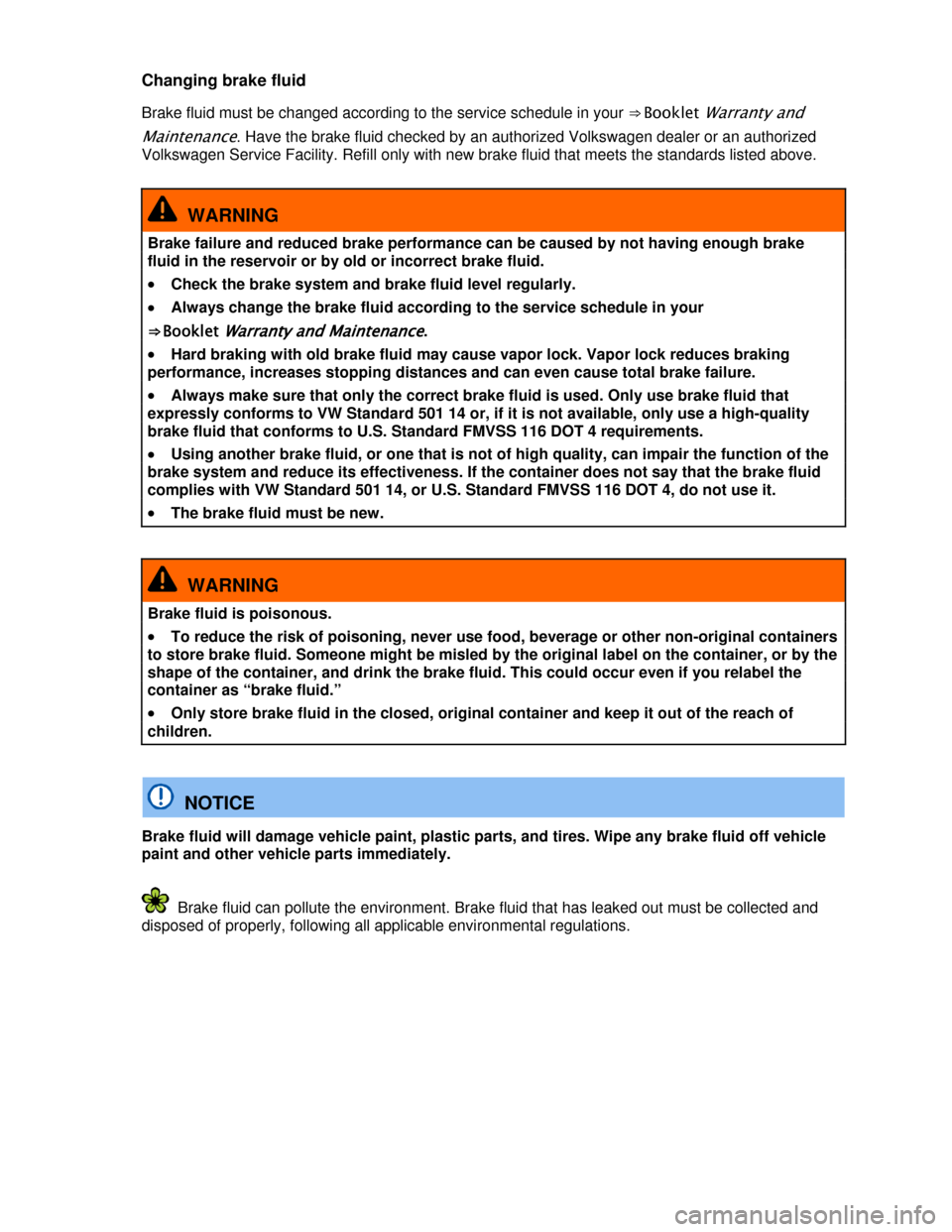
Changing brake fluid
Brake fluid must be changed according to the service schedule in your ⇒ Booklet Warranty and
Maintenance. Have the brake fluid checked by an authorized Volkswagen dealer or an authorized
Volkswagen Service Facility. Refill only with new brake fluid that meets the standards listed above.
WARNING
Brake failure and reduced brake performance can be caused by not having enough brake
fluid in the reservoir or by old or incorrect brake fluid.
�x Check the brake system and brake fluid level regularly.
�x Always change the brake fluid according to the service schedule in your
⇒ Booklet Warranty and Maintenance.
�x Hard braking with old brake fluid may cause vapor lock. Vapor lock reduces braking
performance, increases stopping distances and can even cause total brake failure.
�x Always make sure that only the correct brake fluid is used. Only use brake fluid that
expressly conforms to VW Standard 501 14 or, if it is not available, only use a high-quality
brake fluid that conforms to U.S. Standard FMVSS 116 DOT 4 requirements.
�x Using another brake fluid, or one that is not of high quality, can impair the function of the
brake system and reduce its effectiveness. If the container does not say that the brake fluid
complies with VW Standard 501 14, or U.S. Standard FMVSS 116 DOT 4, do not use it.
�x The brake fluid must be new.
WARNING
Brake fluid is poisonous.
�x To reduce the risk of poisoning, never use food, beverage or other non-original containers
to store brake fluid. Someone might be misled by the original label on the container, or by the
shape of the container, and drink the brake fluid. This could occur even if you relabel the
container as “brake fluid.”
�x Only store brake fluid in the closed, original container and keep it out of the reach of
children.
NOTICE
Brake fluid will damage vehicle paint, plastic parts, and tires. Wipe any brake fluid off vehicle
paint and other vehicle parts immediately.
Brake fluid can pollute the environment. Brake fluid that has leaked out must be collected and
disposed of properly, following all applicable environmental regulations.
Page 169 of 310
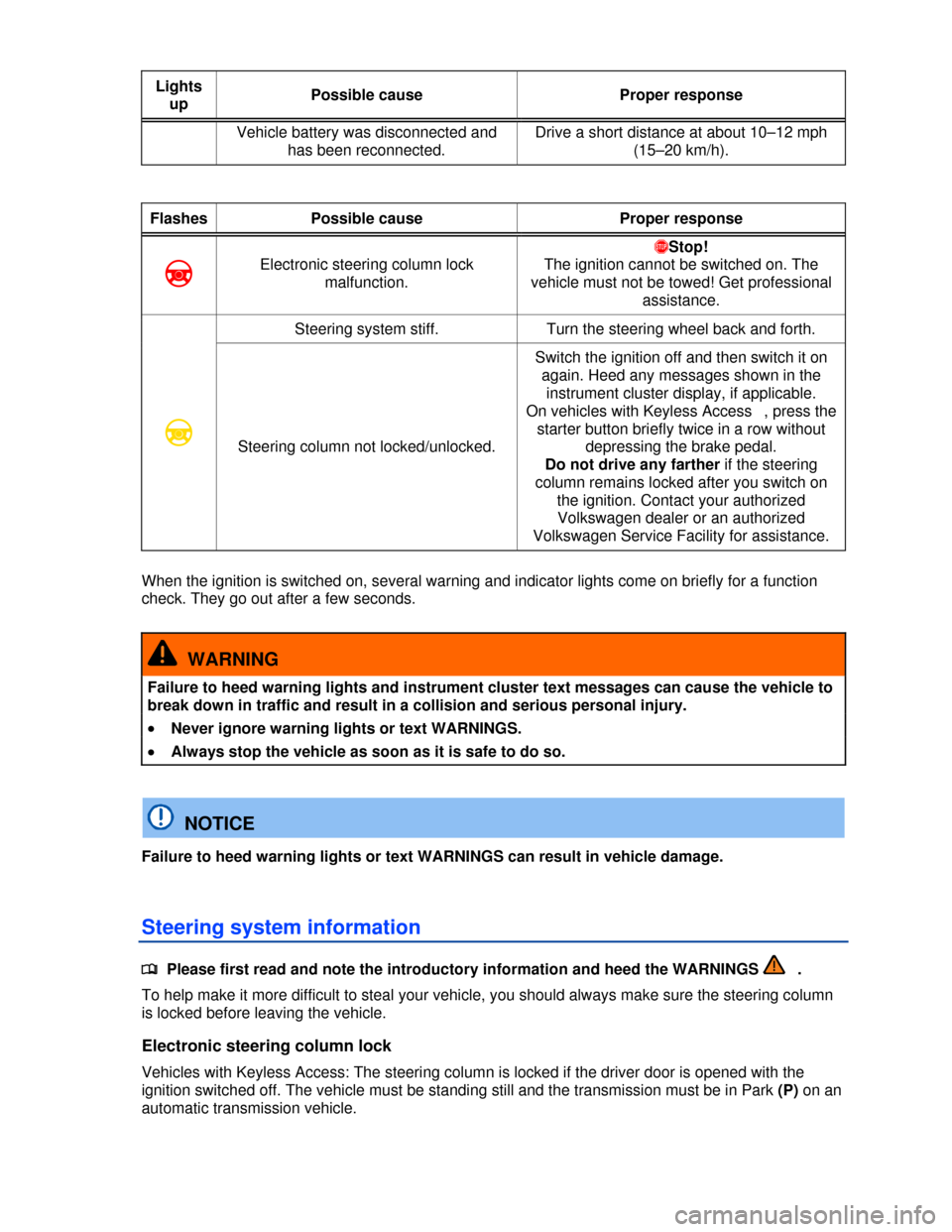
Lights
up Possible cause Proper response
Vehicle battery was disconnected and
has been reconnected.
Drive a short distance at about 10–12 mph
(15–20 km/h).
Flashes Possible cause Proper response
�D Electronic steering column lock
malfunction.
�
Page 170 of 310
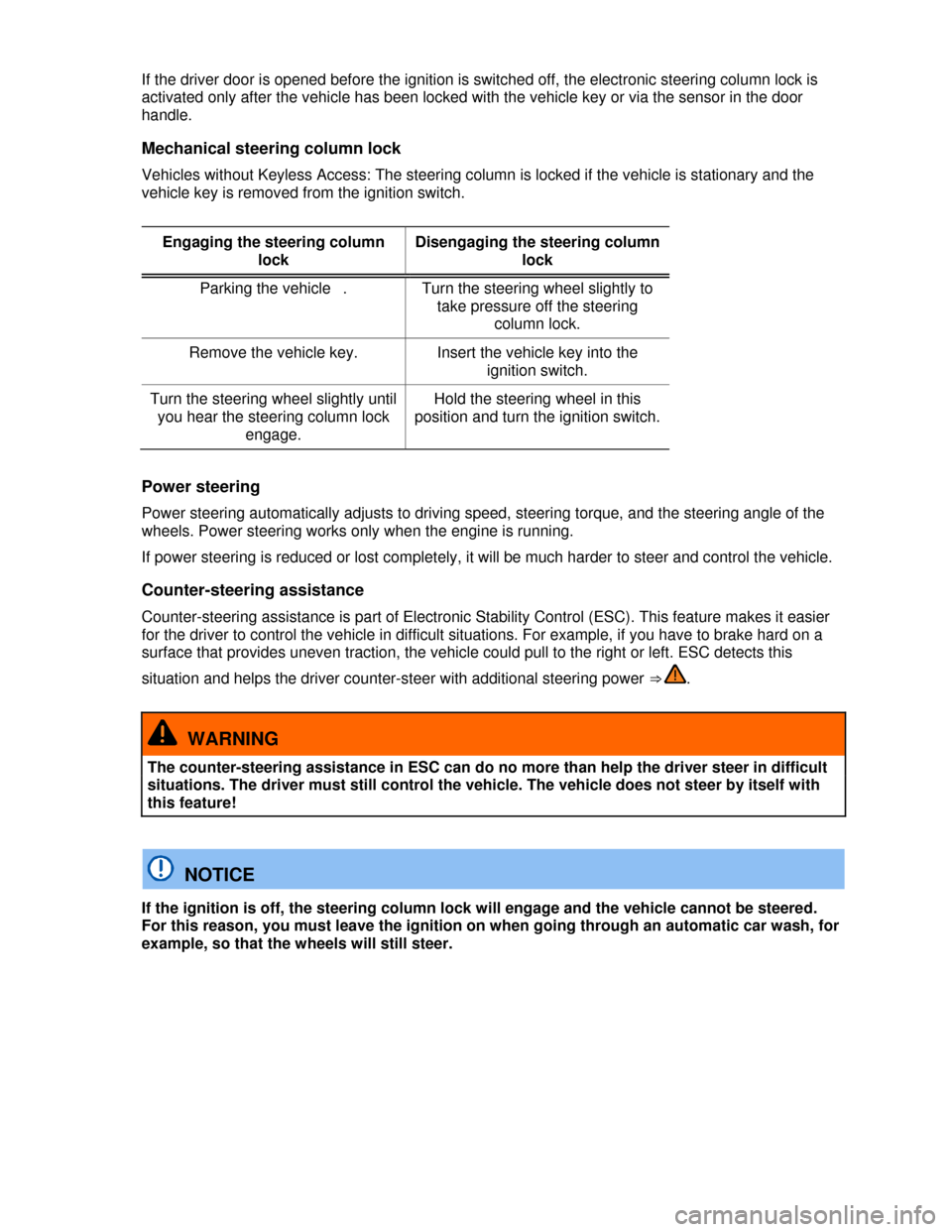
If the driver door is opened before the ignition is switched off, the electronic steering column lock is
activated only after the vehicle has been locked with the vehicle key or via the sensor in the door
handle.
Mechanical steering column lock
Vehicles without Keyless Access: The steering column is locked if the vehicle is stationary and the
vehicle key is removed from the ignition switch.
Engaging the steering column
lock
Disengaging the steering column
lock
Parking the vehicle . Turn the steering wheel slightly to
take pressure off the steering
column lock.
Remove the vehicle key. Insert the vehicle key into the
ignition switch.
Turn the steering wheel slightly until
you hear the steering column lock
engage.
Hold the steering wheel in this
position and turn the ignition switch.
Power steering
Power steering automatically adjusts to driving speed, steering torque, and the steering angle of the
wheels. Power steering works only when the engine is running.
If power steering is reduced or lost completely, it will be much harder to steer and control the vehicle.
Counter-steering assistance
Counter-steering assistance is part of Electronic Stability Control (ESC). This feature makes it easier
for the driver to control the vehicle in difficult situations. For example, if you have to brake hard on a
surface that provides uneven traction, the vehicle could pull to the right or left. ESC detects this
situation and helps the driver counter-steer with additional steering power ⇒ .
WARNING
The counter-steering assistance in ESC can do no more than help the driver steer in difficult
situations. The driver must still control the vehicle. The vehicle does not steer by itself with
this feature!
NOTICE
If the ignition is off, the steering column lock will engage and the vehicle cannot be steered.
For this reason, you must leave the ignition on when going through an automatic car wash, for
example, so that the wheels will still steer.
Page 173 of 310
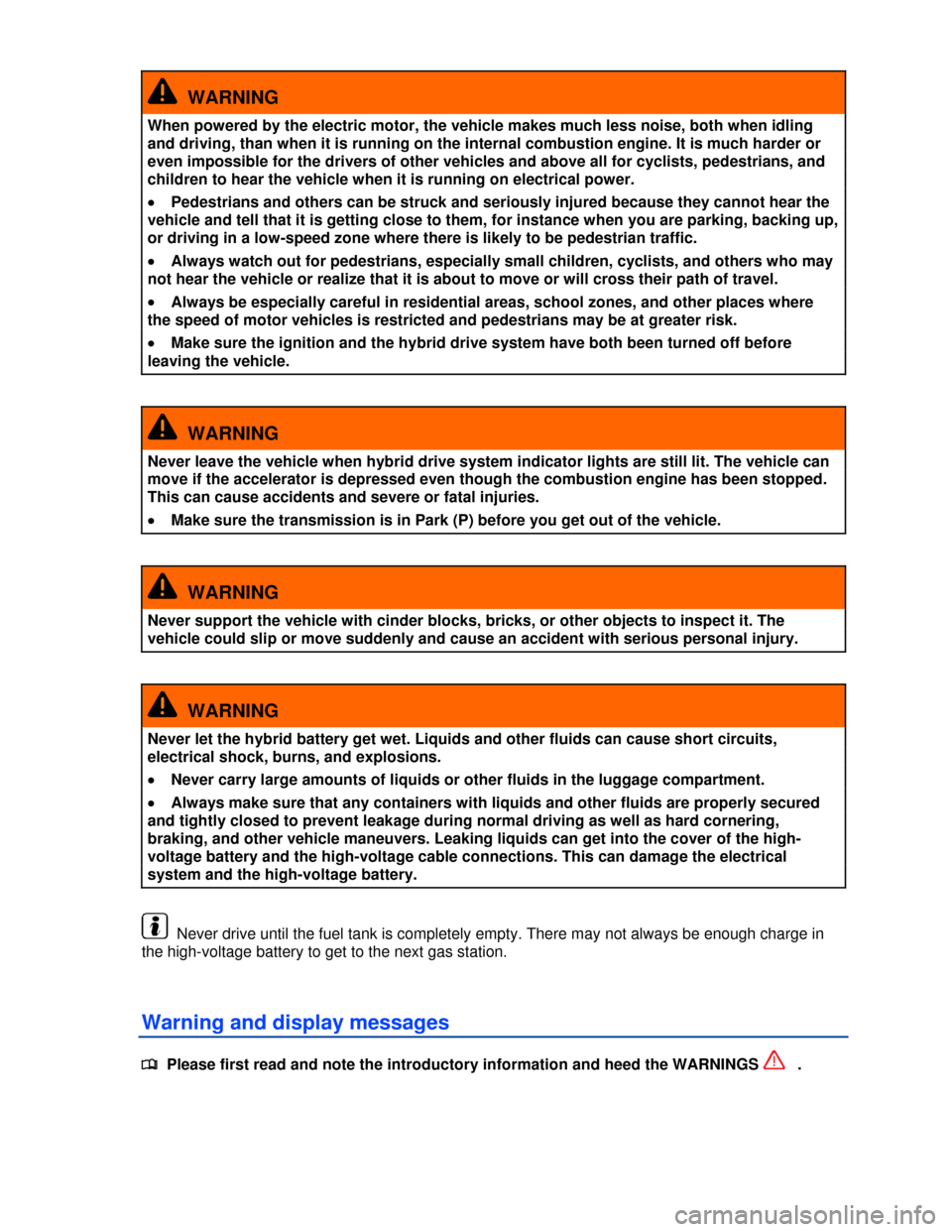
WARNING
When powered by the electric motor, the vehicle makes much less noise, both when idling
and driving, than when it is running on the internal combustion engine. It is much harder or
even impossible for the drivers of other vehicles and above all for cyclists, pedestrians, and
children to hear the vehicle when it is running on electrical power.
�x Pedestrians and others can be struck and seriously injured because they cannot hear the
vehicle and tell that it is getting close to them, for instance when you are parking, backing up,
or driving in a low-speed zone where there is likely to be pedestrian traffic.
�x Always watch out for pedestrians, especially small children, cyclists, and others who may
not hear the vehicle or realize that it is about to move or will cross their path of travel.
�x Always be especially careful in residential areas, school zones, and other places where
the speed of motor vehicles is restricted and pedestrians may be at greater risk.
�x Make sure the ignition and the hybrid drive system have both been turned off before
leaving the vehicle.
WARNING
Never leave the vehicle when hybrid drive system indicator lights are still lit. The vehicle can
move if the accelerator is depressed even though the combustion engine has been stopped.
This can cause accidents and severe or fatal injuries.
�x Make sure the transmission is in Park (P) before you get out of the vehicle.
WARNING
Never support the vehicle with cinder blocks, bricks, or other objects to inspect it. The
vehicle could slip or move suddenly and cause an accident with serious personal injury.
WARNING
Never let the hybrid battery get wet. Liquids and other fluids can cause short circuits,
electrical shock, burns, and explosions.
�x Never carry large amounts of liquids or other fluids in the luggage compartment.
�x Always make sure that any containers with liquids and other fluids are properly secured
and tightly closed to prevent leakage during normal driving as well as hard cornering,
braking, and other vehicle maneuvers. Leaking liquids can get into the cover of the high-
voltage battery and the high-voltage cable connections. This can damage the electrical
system and the high-voltage battery.
Never drive until the fuel tank is completely empty. There may not always be enough charge in
the high-voltage battery to get to the next gas station.
Warning and display messages
�
Page 182 of 310
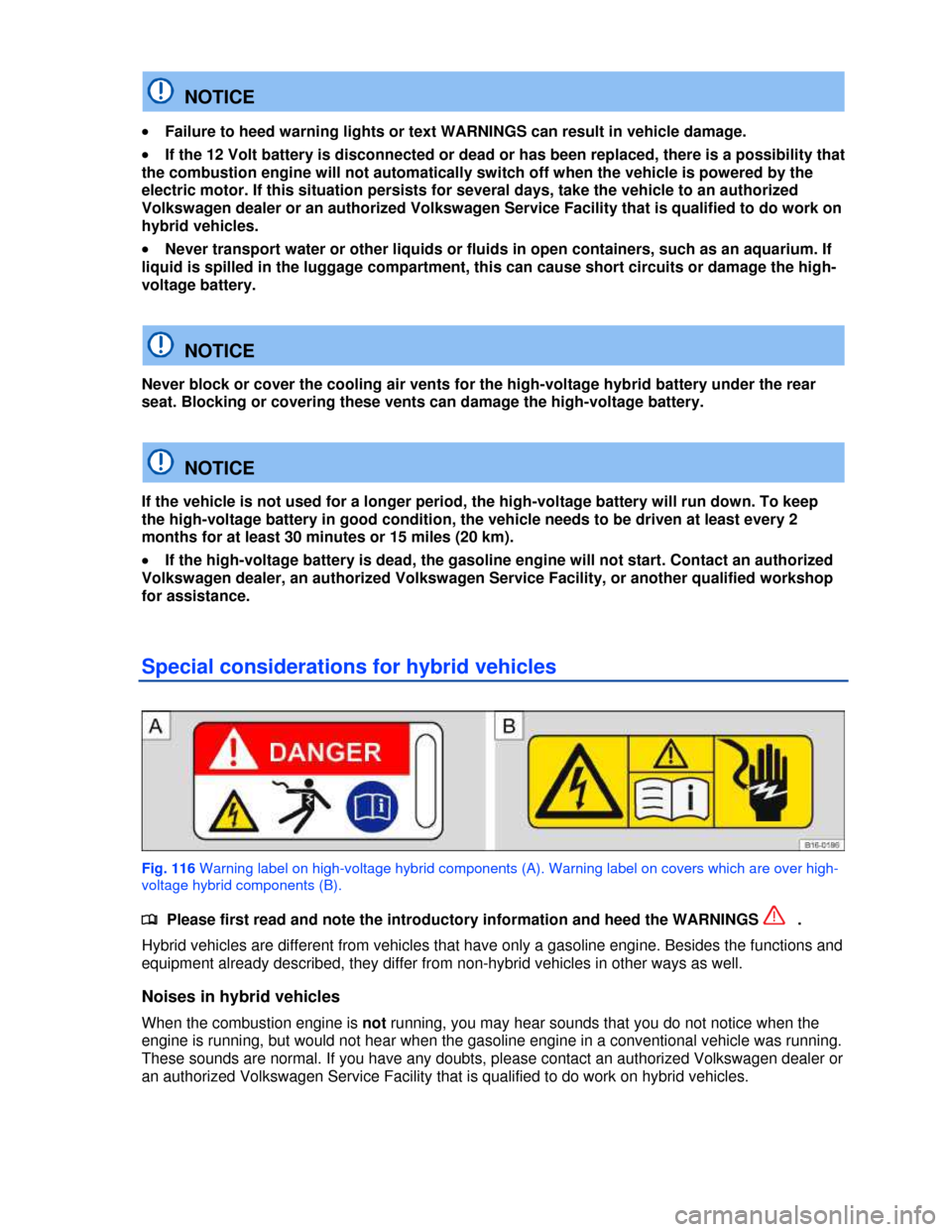
NOTICE
�x Failure to heed warning lights or text WARNINGS can result in vehicle damage.
�x If the 12 Volt battery is disconnected or dead or has been replaced, there is a possibility that
the combustion engine will not automatically switch off when the vehicle is powered by the
electric motor. If this situation persists for several days, take the vehicle to an authorized
Volkswagen dealer or an authorized Volkswagen Service Facility that is qualified to do work on
hybrid vehicles.
�x Never transport water or other liquids or fluids in open containers, such as an aquarium. If
liquid is spilled in the luggage compartment, this can cause short circuits or damage the high-
voltage battery.
NOTICE
Never block or cover the cooling air vents for the high-voltage hybrid battery under the rear
seat. Blocking or covering these vents can damage the high-voltage battery.
NOTICE
If the vehicle is not used for a longer period, the high-voltage battery will run down. To keep
the high-voltage battery in good condition, the vehicle needs to be driven at least every 2
months for at least 30 minutes or 15 miles (20 km).
�x If the high-voltage battery is dead, the gasoline engine will not start. Contact an authorized
Volkswagen dealer, an authorized Volkswagen Service Facility, or another qualified workshop
for assistance.
Special considerations for hybrid vehicles
Fig. 116 Warning label on high-voltage hybrid components (A). Warning label on covers which are over high-
voltage hybrid components (B).
�
Page 210 of 310

Display text Proper response
Press button again to
refuel!
Fuel filler cap not properly closed ò
If the indicator light ò comes on or you see a text message in the instrument cluster display indicating
that the fuel filler cap is not properly closed, stop the vehicle in a safe place and switch off the engine
and the ignition.
Open the fuel filler flap and take the fuel filler cap off the filler neck. Then put the fuel filler cap back on
the filler neck and screw it on clockwise until you clearly hear a clicking sound. Close the fuel filler flap.
After switching on the ignition, the indicator light ò may stay on or the text message may still appear in
the instrument cluster display, even if the fuel filler cap is now properly closed. This is normal and no
reason to take your vehicle in for service.
If, however, the malfunction indicator light x also comes on, drive to your nearest authorized
Volkswagen dealer or authorized Volkswagen Service Facility and have the fuel system and the
engine checked.
WARNING
Driving with a fuel tank that is almost empty can lead to stalling in traffic, a collision, and
serious personal injuries.
�x When the fuel tank is almost empty, fuel supply to the engine can be interrupted,
especially when driving over bumps, across slopes, and up and down hills.
�x Steering and braking assistance as well as ESC and related systems will not work if the
engine “sputters” or stalls due to lack of fuel.
�x Always refuel when the tank is 1/4 full to reduce the risk of running out of fuel and stalling
in traffic.
NOTICE
�x Failure to heed warning lights or text WARNINGS can result in vehicle damage.
�x Never drive until the fuel tank is completely empty. The irregular fuel supply can cause the
engine to misfire. This allows unburned fuel to get into the exhaust system and damage the
catalytic converter.
NOTICE
If the fuel tank venting system malfunctions and the fuel tank cannot be properly vented before
refueling:
�x Gasoline fumes can escape from the fuel filler neck, resulting in temporary odors.
�x The fuel nozzle may shut off during refueling and it will take longer to refuel the vehicle.
Only in this situation can you continue to carefully refuel your vehicle after the fuel nozzle
shuts off.
�x See your Authorized Volkswagen dealer or authorized Volkswagen Service Facility to have
your vehicle checked.
The small arrow next to the gas pump symbol in the fuel gauge shows the side of the vehicle with
the fuel filler flap.
Page 216 of 310

WARNING
The engine compartment of any motor vehicle is a potentially dangerous area and can cause
serious personal injury.
�x Always use extreme caution when doing any work in the engine compartment. Always
follow commonly accepted safety practices and use common sense. Never risk personal
injury.
�x Never perform any work in the engine compartment unless you know exactly how to carry
out the job and have the correct technical information and the correct tools.
�x If you are uncertain about what to do, have the work performed by an authorized
Volkswagen dealer, an authorized Volkswagen Service Facility, or another qualified
workshop. Serious personal injury may result from improperly performed work.
�x We strongly recommend that you always have HID – High Intensity Discharge (Xenon)
headlights and H7 bulbs replaced by a qualified technician. Serious personal injury may
result from improperly performed work.
�x Never open or close the engine hood if steam or coolant is escaping. Hot steam or coolant
can cause serious burns. Always wait until you no longer see or hear steam or coolant
escaping from the engine.
�x Always let the engine cool down completely before carefully opening the hood.
�x Hot parts of the engine and the exhaust system will burn skin on contact.
�x When the engine has cooled down and you are ready to open the hood:
– Firmly apply the parking brake and shift the transmission into Park (P).
– Take the vehicle key out of the ignition.
– On vehicles with Keyless Access, make sure that the remote control vehicle key is out
of range of the vehicle and that the vehicle cannot be started by depressing the starter
button .
– Always keep children and others away from the engine compartment and never leave
them unsupervised.
�x The engine coolant system is under pressure when the engine is hot. Never unscrew the
coolant expansion tank cap when the engine is hot. Hot coolant can spray out and cause
severe burns and other serious injuries.
– Turn the cap slowly and very carefully in a counterclockwise direction while applying
light downward pressure on the top of the cap.
– Always protect your face, hands, and arms from hot escaping coolant or steam by
covering the cap with a large, thick rag.
�x Never spill fluids on the engine or exhaust system when refilling. Spilling fluids onto hot
parts of the engine or exhaust system can cause a fire.
WARNING
High voltage systems in the engine compartment can cause electrical shocks or even
electrocution, severe burns, other serious injuries, and even death!
�x Never short-circuit the electrical system. Be especially careful when using jumper cables.
The vehicle's battery could explode!
�x To reduce the risk of electrical shock and personal injury while the engine is running or
being started:
– Never touch ignition cables. Never touch other components of the high voltage
electronic ignition system.
– Never touch the wiring of the HID – High Intensity Discharge (Xenon) headlights.
�x Read and heed the important information and warnings on cleaning the engine
compartment or! Bookmark not defined., Cleaning the engine compartment